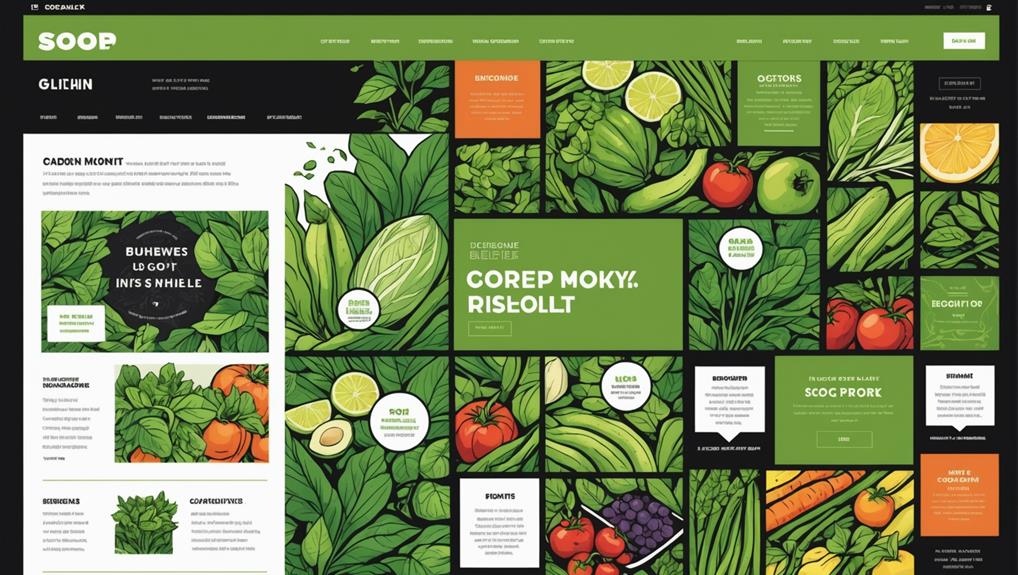
To build trust and credibility as a nutritionist, focus on designing a professional website that reflects your unique style. Use a clean layout with easy navigation, as many visitors might leave if it's too complicated. Make sure your site works well on mobile, since over half of users will access it this way. Use engaging content, like practical nutrition tips, to connect with your audience. Don't forget clear calls to action, like "Book Now," to encourage engagement. Each step you take strengthens your online presence, and there's so much more to explore that can enhance your journey.
Key Takeaways
- Establish a cohesive brand style with a unified color palette and minimalistic design to enhance professionalism and trustworthiness.
- Prioritize user experience with easy navigation and mobile optimization to retain visitors and improve engagement.
- Create clear calls to action (CTAs) that prompt immediate engagement, using contrasting colors for better visibility.
- Publish engaging and relevant content like blog articles to showcase expertise and improve SEO for increased visibility.
- Utilize local SEO strategies and social media engagement to build community connections and enhance credibility among potential clients.
Establish a Professional Brand Style

How can you create a lasting impression with your website? Start by establishing a professional brand style that reflects your unique approach to nutrition services. A cohesive brand style uses a unified color palette and limited fonts, enhancing visual professionalism. Did you know that 75% of a website's credibility comes from its look? That's huge! Consider utilizing custom brand building services to guarantee your design resonates with your target audience.
Consider a minimalistic design. This approach keeps your website clean and clutter-free, making it easier for clients to understand your offerings. Engaging visuals like personalized images and infographics not only capture attention but also show your commitment to professionalism in the nutrition field.
Branding consistency across all platforms builds trust and credibility with potential clients. When your style is appealing and consistent, it encourages visitors to return to your site, which is crucial for nurturing client relationships.
Prioritize User-Friendly Navigation
A visually appealing website is only part of the equation; user-friendly navigation is just as important for keeping visitors engaged. If your site is hard to navigate, you might lose over 50% of your visitors! That's why you should make important sections, like your services and clear contact information, easily accessible in the navigation bar. This helps boost user experience and keeps people coming back.
Consider adding breadcrumb navigation, too. It shows users where they are on your site, making it simpler to explore without getting lost. A clean layout is vital as well. An organized design allows visitors to find what they need quickly, reducing confusion and frustration.
Don't forget about mobile optimization! Since more than half of web traffic comes from mobile devices, make sure your navigation is thumb-friendly. Easy-to-click buttons can greatly improve client engagement. By prioritizing user-friendly navigation, you create a website that not only looks great but also provides a seamless experience. This way, visitors can focus on your valuable website content, leading to more connections and happier clients.
Implement Responsive Design

When you implement responsive design, you're making sure your nutrition practice website looks great on any device, whether it's a smartphone or a computer. This not only keeps visitors happy, but it also helps them navigate easily to find the information they need. Plus, with more people browsing on mobile, a responsive site can boost your visibility and attract new clients!
Mobile Optimization Importance
With over half of all internet traffic coming from mobile devices, mobile optimization isn't just a nice-to-have—it's vital for your website's success. If you want to attract more clients and keep them engaged, implementing responsive design is key. Here are three reasons why mobile optimization matters:
- User Engagement: A mobile-friendly site enhances user engagement. If your website is easy to navigate on a phone, users are more likely to stay and explore.
- Bounce Rates: When a site isn't easily navigable, users often leave quickly. High bounce rates can hurt your reputation, so a seamless experience is important.
- Search Rankings: Google prioritizes mobile-responsive websites. This means a well-optimized site can boost your visibility in local SEO results, helping new clients find you easily.
User-Friendly Navigation Elements
Effective navigation elements are fundamental for creating a user-friendly experience on your nutritionist website. When you implement responsive design, your website resizes beautifully across devices, making it easier for visitors to engage with potential clients. A clean layout helps minimize clutter, allowing users to find what they need without feeling overwhelmed.
By streamlining navigation with features like breadcrumb navigation, you clarify user paths. This makes exploring significant information a breeze, reducing bounce rates and keeping users on your site longer. Mobile optimization is also essential. Thumb-friendly buttons guarantee easy access to critical services on-the-go, enhancing navigation efficiency for those using smartphones or tablets.
When visitors enjoy a consistent experience, regardless of the device they're on, it builds trust in your professional online presence. This trust is crucial for attracting and retaining clients. So, remember to prioritize user-friendly navigation on your site. It not only improves user experience but also helps you connect with people seeking your expertise. With thoughtful design choices, you can create a welcoming space that encourages visitors to stick around and learn more about the nutrition services you offer.
Consistent Cross-Device Experience
Frequently, visitors access your nutritionist website from various devices, making a consistent cross-device experience crucial. With more than half of users browsing on mobile devices, you need to make certain that your website looks great on all screens. Here are three key benefits of implementing responsive design:
- Consistent User Experience: Responsive design maintains a seamless experience across devices, which keeps potential clients engaged. If your navigation menus are complicated on mobile, users might leave quickly.
- Improved Accessibility: Responsive design allows for thumb-friendly buttons and easy navigation, making it simpler for users to interact with your content. This improves user satisfaction and encourages them to explore more.
- Boosted SEO and Fast Loading Speeds: A well-designed, responsive site aligns with search engine algorithms, helping you attract more potential clients. Plus, fluid grids and flexible images make certain your site loads quickly, which reduces bounce rates.
Create Engaging and Relevant Content
Creating engaging and relevant content is key for connecting with your audience. You can start by writing informative blog articles that address common nutrition questions, making your expertise shine. Don't forget to mix in visual content like infographics and videos, which can really help your readers understand and enjoy the information you share!
Informative Blog Articles
Engaging blog articles can be a game-changer for nutritionists looking to connect with their audience. By sharing informative content, you not only show your expertise but also build credibility and trust with potential clients. Here are three key tips to create valuable blog posts:
- Focus on Practical Topics: Cover dietary trends and health tips that people want to know about. This will attract visitors and encourage them to return for more valuable insights.
- Use SEO Strategies: Integrate relevant keywords throughout your blog posts. This helps improve your content's visibility in search engine results, making it easier for potential clients to find you.
- Encourage Interaction: Allow comments and sharing on social media. This fosters community engagement and helps build trust with potential clients, making them feel connected to your work.
Visual Content Integration
While informative blog articles lay the groundwork for establishing your expertise, integrating visual content can take your website to the next level. High-quality visual content, like infographics and before-and-after images, can enhance engagement by making your information more appealing. Did you know that visuals can improve user retention by up to 65%? Using professional photography and cohesive color palettes not only makes your site look great but also builds trust—75% of website credibility comes from design quality!
Don't forget to include testimonial graphics that showcase client success stories. These act as social proof and help build rapport with potential clients. When people see real results, they're more likely to believe in your services. Adding interactive visual elements, such as videos or sliders, can make learning about nutrition fun and dynamic. These features can keep visitors on your site longer, allowing them to absorb more information.
Lastly, consistent branding across all your visual content reinforces your identity. This makes it easier for potential clients to recognize and remember your nutrition service. So, invest in visual content integration, and watch your online presence flourish!
Utilize Clear Calls to Action

Calls to action (CTAs) are essential for guiding visitors on your nutritionist website toward the next steps. When you use clear calls to action, you create an engaging user experience that encourages potential clients to take action. Here are three effective strategies to enhance visibility and boost conversion rates:
- Be Direct: Use phrases like "Book Now" or "Get Your Free Consultation." These effective CTAs create urgency and prompt users to engage with your content.
- Strategic Placement: Position your CTAs near relevant content, such as client testimonials or descriptions of your design services. This enhances context, making it easier for visitors to understand their next steps.
- Stand Out: Utilize contrasting colors for your buttons. Studies show that buttons that stand out can increase click-through rates by up to 200%.
Regularly testing and optimizing your CTAs through A/B testing can lead to even better results. Small changes can make a big difference in user response. By implementing these strategies, you can improve your website's user experience and encourage more visitors to book consultations, ultimately helping your nutrition practice thrive!
Optimize for Mobile Users
As you enhance your website with clear calls to action, don't forget the importance of optimizing for mobile users. With over 54% of web traffic coming from mobile devices, having a mobile-responsive design is crucial for your nutrition website. This means using fluid grids and flexible images so visitors can easily navigate your site, no matter what device they're on. By optimizing for mobile, you create a seamless experience that leads to higher engagement and lower bounce rates.
Make certain to include touch-friendly navigation and thumb-friendly buttons. This small change can greatly improve user experience (UX) and simplify client interactions. When your website is easy to use on mobile, people are more likely to stay and explore what you offer.
Don't forget that a mobile-optimized site can also boost your search engine rankings. Google prioritizes mobile-friendly sites, which means more potential clients can find you online. Finally, test your website across different mobile devices. This allows you to spot any issues and guarantees your content is accessible and visually appealing. By focusing on these elements, you're not just improving your site; you're building trust with your audience.
Enhance Local SEO Strategies

To attract more local clients, enhancing your local SEO strategies is vital for your nutrition practice. By doing this, you can reach more people searching for services like yours. Here are three effective strategies to acknowledge:
- Optimize Your Google My Business Listing: This is essential! Make sure your business information is accurate and up-to-date. This helps your online presence shine in local search results and on maps.
- Incorporate Relevant Local Keywords: Use phrases like "nutritionist in [your city]" or "dietitian near me." These keywords can greatly improve your search rankings and attract clients actively looking for your services.
- Gather Positive Local Reviews: Displaying positive local reviews not only boosts your search rankings but also builds trust and credibility. Remember, 85% of consumers trust online reviews as much as personal recommendations.
Additionally, consistently create localized content, like blog posts about local nutrition trends or events, to showcase your community expertise. By implementing these local SEO strategies, you'll connect with more potential clients and grow your practice. Keep pushing forward; the effort will pay off!
Leverage Social Media Engagement
Building on your local SEO efforts, leveraging social media engagement can markedly enhance your nutrition practice's visibility and connection with potential clients. Platforms like Instagram and Facebook offer a fantastic way to reach your target audience. By posting valuable content, like recipes and nutrition tips, you can not only engage your community but also build brand loyalty. Studies show that consistent engagement can boost loyalty by up to 60%.
With the average user spending about 2 hours and 31 minutes daily on social media, there's a golden opportunity for you to connect with potential clients. Tailoring your content to their interests can lead to better conversion rates, especially when you utilize social media ads to reach specific demographics actively seeking health and wellness information.
Don't forget to use social media analytics tools. They can help you track engagement and understand user behaviors, allowing you to refine your approach. This way, you can continually improve your strategies and create a stronger relationship with your clients. Embrace social media engagement, and watch your nutrition practice grow!
Continuously Analyze and Improve

Regularly analyzing your website is essential for enhancing user engagement and ensuring your content remains relevant. By understanding user behavior patterns, you can make informed choices about design improvements that keep your clients interested. Here are three effective ways to do this:
- Utilize Analytics Tools: Measure website performance metrics like traffic sources and bounce rates. This data helps you identify what's working and what needs change.
- A/B Testing: Try out different website elements, such as call-to-action buttons or layouts. This real-time data can guide you toward optimizing user experience (UX) and boosting conversions.
- Feedback Loops: Pay attention to client interactions. Their feedback provides insights into service effectiveness and areas for enhancement, which fosters trust and loyalty.
Frequently Asked Questions
What Is the Best Website Builder for Nutritionists?
For nutritionists, Wix offers user-friendly interfaces and mobile responsiveness. WordPress excels in SEO optimization, while Squarespace provides visual appeal. Consider client testimonials, social media integration, online booking, e-commerce functionality, and secure hosting when choosing.
What Are Characteristics of Reliable Websites for Nutrition Information?
Reliable nutrition websites have a user-friendly layout with clear navigation, updated content, and a professional appearance. They feature evidence-based resources, author credentials, client testimonials, interactive features, mobile compatibility, and strong security measures to guarantee trust.
What Strategies Can Be Used to Find Reliable Nutrition Information on Websites and Trustworthy Sources?
Finding reliable nutrition information's like steering through a maze—use evidence-based guidelines, check peer-reviewed research, verify credentials, consult professional organizations, and read user testimonials to guarantee content accuracy and adherence to dietary standards.
Which Website Will Give Trustworthy Nutrition Information?
To find trustworthy nutrition information, look for websites featuring registered dietitians, peer-reviewed studies, and clinical guidelines. Check for evidence-based nutrition content, reputable sources, and health organization recommendations to guarantee credibility and accuracy.
Final Thoughts
In the end, building a trustworthy website as a nutritionist can really set you apart. Have you ever thought about how a well-designed site can make someone feel more comfortable reaching out for help? By following these tips, like creating engaging content and optimizing for mobile users, you can connect with more people. So, embrace these strategies and watch your online presence grow. Remember, every small step counts in building your credibility and helping others lead healthier lives!
- Writing Content That Converts Visitors Into Customers - 04/11/2025
- How to Plan a Content Calendar That Works - 29/10/2025
- SEO Content vs. Social Media Content: What’s the Difference? - 23/10/2025




